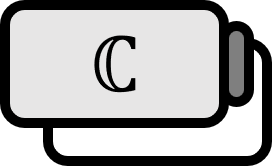Proof of Roché's Theorem
Theorem 1
If $f$ and $g$ are analytic within a simple closed path $\mathscr{C}$ and its interior and satisfy $|g(z)| < |f(z)|$ on $\mathscr{C}$, then $f$ and $f + g$ have the same number of zeros in the interior of $\mathscr{C}$.
Description
This theorem involves considering the given function as $h = f + g$ and smartly dividing it into $f$ and $g$. Especially for polynomial functions, such manipulation is very straightforward, making it very useful. Moreover, coupled with numerical methods, it is possible to determine the specific location of the solutions to equation $h(z) = 0$ quite accurately.
Proof
Strategy: Define $Z$ such that $Z(0)$ represents the number of zeros of $f$, and $Z(1)$ represents the number of zeros of $g$, and show that $Z(0) = Z(1)$ holds. The function value of $Z$ is an integer, and if it is a continuous function, then the only such $Z$ would be a constant function, hence obtaining $Z(0) = Z(1)$.
Considering $h(z,t) := f(z) + t g(z)$ for $t \in [0,1]$, since $f$ and $g$ are analytic within $\mathscr{C}$ and its interior, $h(z,t)$ does not have any poles within $\mathscr{C}$ and its interior for a fixed $t$. If $f(z) + t g(z) = 0$ then $$ |f(z)| = |-tg(z)| = |tg(z)| $$ but since $t \in [0,1]$, then $|f(z)| \le |g(z)|$. This contradicts the assumption, hence $f(z) + t g(z) \ne 0$ must hold.
With $f(z) + t g(z) \ne 0$, a new function $\displaystyle Z(t) := {{1} \over {2 \pi i}} \int_{\mathscr{C}} {{f ' (z) + t g ' (z) } \over {f(z) + t g (z) }} dz$ can be defined.
Based on the definition of $Z: [0,1] \to \mathbb{Z}$, $Z(t)$ represents the number of zeros of a rational function $f(z) + t g (z)$. Here, if $t=0$ then $Z(0)$ is the number of zeros of $f$, and if $t=1$ then $Z(1)$ is the number of zeros of $f+g$. Hence proving $Z(0) = Z(1)$ concludes the proof.
Furthermore, since the range of $Z: [0,1] \to \mathbb{Z}$ is the set of integers $\mathbb{Z}$, if $Z$ is a continuous function, then $Z$ can only be a constant function. Calculating $| Z(t) - Z(s)|$ leads to finding $$ |Z(t) - Z(s)| = {{ |t-s| } \over {2 \pi}} \left| \int_{\mathscr{C}} {{f(z) g ' (z) - f '(z) g(z)} \over { (f(z) + t g(z))(f(z) + s g(z)) }} dz \right| $$ Meanwhile, $$ | f(z) + t g(z) | \ge |f(z)| - t |g(z)| \ge |f(z)| - |g(z)| > 0 $$
$$ | f(z) + s g(z) | \ge |f(z)| - |g(z)| > 0 $$ Since $\mathscr{C}$ is compact, according to the maximum and minimum value theorem, there exists a $M>0$ that satisfies $\displaystyle \left| {{f(z) g ' (z) - f '(z) g(z)} \over { (|f(z)| - |g(z)|)^2 }} \right| \le M$.
ML Lemma: Given a positive number $|f(z)| \le M$ and the length $L$ of $\mathscr{C}$, $$ \left| \int_{\mathscr{C}} f(z) dz \right| \le ML $$
If the length of $\mathscr{C}$ is $L$, then $$ |Z(t) - Z(s)| \le |t - s|{{ML} \over {2 \pi}} $$ Hence, when $| t - s | \to 0$, $ | Z(t) - Z(s) | \to 0$, which implies that $Z$ is (uniformly) continuous. Since the function values of $Z(t)$ are integers, to maintain continuity, $Z$ can only be a constant function, thus obtaining $Z(0) = Z(1)$.
■
Osborne (1999). Complex variables and their applications: p100. ↩︎
